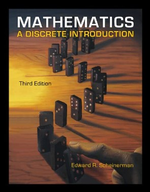This exercise generalizes the previous two. Let .G; / and .H; / be groups. Their direct
Chapter 41, Problem 41.4(choose chapter or problem)
This exercise generalizes the previous two. Let .G; / and .H; ?/ be groups. Their direct product is a new group .G; / .H; ?/ whose elements are all ordered pairs .g; h/ where g 2 G and h 2 H. The operation for this group (lets use the symbol ) is defined by .g1; h1/ .g2; h2/ D .g1 g2; h1 ? h2/: For example, lets consider .Z 5 ; / .Z3; /. We have Z 5 D f1; 2; 3; 4g and Z3 D f0; 1; 2g and therefore the elements of .Z 5 ; / .Z3; / are f.1; 0/; .1; 1/; .1; 2/; .2; 0/; .2; 1/; .2; 2/; .3; 0/; .3; 1/; .3; 2/; .4; 0/; .4; 1/; .4; 2/g: Copyrigh The operation .g1; h1/.g2; h2/ produces the value .g; h/ where g D g1g2 (operatingin Z5) and h D g1 g2 (operating in Z5). For example,.2; 1/ .3; 2/ D .2 3; 1 2/ D .1; 0/:You should convince yourself that if .G; / and .H; ?/ are groups, then .G; /.H; ?/ is also a group. [Optional: Write a formal proof of this.]We now come to the point of this problem: If .G; / and .H; ?/ are finite cyclicgroups, then sometimes .G; / .H; ?/ is cyclic and sometimes it is not. The questionis, under what condition(s) is the direct product of two finite cyclic groups also cyclic?41.5.
Unfortunately, we don't have that question answered yet. But you can get it answered in just 5 hours by Logging in or Becoming a subscriber.
Becoming a subscriber
Or look for another answer
